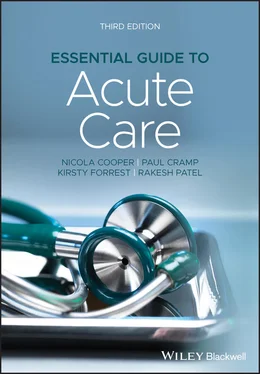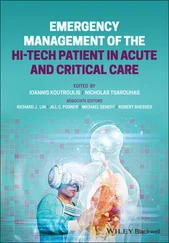Level 3 is equivalent to ICU care.
Early experience in the UK suggested that medical emergency teams instead of cardiac arrest teams reduced ICU mortality and the number of cardiac arrests, partly through an increase in ‘do not attempt CPR’ orders. 11In 1999, the report ‘Critical to Success – the place of efficient and effective critical care services within the acute hospital’ 14re‐emphasised the concept of the patient at risk, advocating for better training of medical and nursing staff and ‘outreach’ critical care. The report commented that intensive care is something that tends to happen within four walls, but that patients should not be defined by what bed they occupy, but by their severity of illness (see Table 1.2).
Following this, ‘Comprehensive Critical Care – a review of adult critical care services’ 15was published and reiterated the idea that patients should be classified according to their severity of illness and the necessary resources mobilised. With this report came funding for critical care outreach teams and an expansion in critical care beds. In the USA and parts of Europe, there is considerable provision of level 1 and 2 facilities. In most UK hospitals it is recognised that there are not enough 16,17even with the 10% increase in critical care beds that has taken place in England between 2011 and 2018. 18
Although there are many different variations of early warning scores in use, it is probably the recognition of abnormal physiology, however measured, and a protocol that requires inexperienced staff to call for help that makes a difference, rather than the score itself. Patients at particular risk are recent emergency admissions, after major surgery, and following discharge from intensive care.
Do Early Warning Scores and Medical Emergency Teams Make a Difference?
Early warning scores are based on the use of aggregate weighting scoring systems, whereas the original MET calling criteria were based on single parameters, including the concern of ‘worried’ ward staff. The idea behind these trigger systems is very simple: patients often have a prolonged period of physiological instability prior to admission to the ICU, and the earlier this can be identified, the better the overall outcome.
There does not seem to be evidence that implementation of a single parameter trigger system alone improves patient outcomes, but there is evidence that the introduction of aggregate weighting scoring systems (e.g. NEWS2) improves survival and reduces unplanned ICU admissions and cardiac arrests. Likewise, when compared with standard care, medical emergency teams improve hospital survival, reduce unplanned ICU admissions, and reduce cardiac arrests, although their effect on hospital length of stay and ICU mortality remains unclear. 19
The UK has focussed on identifying the deteriorating patient using aggregate weighting scoring systems, but the response to patients identified as being sick requires significant improvements. In Australia, where medical emergency teams are established, the identification of deteriorating patients using a single parameter trigger system has been less successful. Overall, for a rapid response system to be effective, it appears that a whole system approach is needed which includes trigger systems that identify deteriorating patients, clinician‐led medical emergency teams, and continuing education programmes.
History, examination, differential diagnosis followed by treatment will not immediately help someone who is critically ill. Diagnosis is irrelevant when the things that kill first are literally A (airway compromise), B (breathing problems), and C (circulation problems) – in that order. What the patient needs is resuscitation not deliberation. Patients can be alert and ‘look’ well from the end of the bed, but the clue is often in objective vital signs and key test results. Box 1.2summarises the physiological and biochemical markers of severe illness. A common theme in studies is the inability of hospital staff to recognise when a patient is at risk of deterioration, even when these abnormalities are documented.
Box 1.2Markers of Severe Illness
Physiological
Signs of sympathetic activation e.g. tachycardia, hypertension, pale, shut down
Signs of hypoperfusion (see Chapter 5)
Signs of organ failure (see Chapter 6)
Biochemical
Metabolic (lactic) acidosis
High or low white cell count
Low platelet count
High creatinine
High C‐reactive protein (CRP)
The most common abnormalities before cardiac arrest are hypoxaemia with an increased respiratory rate and hypotension leading to hypoperfusion with an accompanying metabolic acidosis and tissue hypoxia. If this is left untreated, a downward physiological spiral ensues. With time, these abnormalities may become resistant to treatment with fluids and drugs. Therefore, early action is vital. The following chapters teach the theory behind ABCDE in more detail. Practical courses also exist which use scenario‐based teaching on how to manage patients at risk (see further resources). These are recommended because the ABCDE approach described below requires practical skills (e.g. assessment and management of the airway) which cannot be learned adequately from a book.
ABCDE is the initial approach to any patient who is acutely ill:
A – assess airway and treat if needed
B – assess breathing and treat if needed
C – assess circulation and treat if needed
D – assess disability and treat if needed
E – expose and examine patient fully once A, B, C, and D are stable. Further information gathering and tests can be done at this stage
Do not move on without treating an abnormality. For example, there is no point in doing an arterial blood gas on a patient with an airway obstruction
A more detailed version of the ABCDE system is shown in Box 1.3.
Airway
Examine for signs of upper airway obstruction
If necessary, do a head tilt‐chin lift manoeuvre
Suction (only what you can see)
Simple airway adjuncts may be needed
Give oxygen if needed (see Chapter 2for more details)
Breathing
Look at the chest
Assess rate, depth, and symmetry of movement
Measure SpO 2
Quickly listen with a stethoscope (for air entry, wheeze, crackles)
You may need to use a bag and mask if the patient has inadequate ventilation
Treat wheeze, pneumothorax, fluid, collapse, infection, etc. (is a physiotherapist needed?)
Circulation
Assess limb temperature, capillary refill time, blood pressure, pulse, urine output
Insert a large bore cannula and send blood for tests
Give a fluid challenge if needed (see Chapter 5for more details)
Disability
Make a note of the AVPU scale ( a lert, responds to v oice, responds to p ain, u nresponsive)
Check pupil size and reactivity
Measure capillary glucose
Examination and Planning
Are ABCD stable? If not, go back to the top and call for help
Complete any relevant examination e.g. heart sounds, abdomen, full neurological exam
Treat pain
Gather information from notes, charts, and eyewitnesses
Do tests e.g. arterial blood gases, X‐rays, ECG
Do not move an unstable patient without the right monitoring equipment and staff
Make ICU and CPR decisions
You should have called a senior colleague by now, if you have not done so already.
Patients with serious abnormal vital signs are an emergency. The management of such patients requires proactivity, a sense of urgency, and the continuous presence of the attending doctor. For example, if a patient is hypotensive and hypoxaemic from pneumonia, it is not acceptable for oxygen, fluids, and antibiotics simply to be prescribed. The oxygen concentration may need to be changed several times before the PaO 2is acceptable. More than one fluid challenge may be required to get an acceptable blood pressure – and even then, vasopressors may be needed if the patient remains hypotensive due to septic shock. Intravenous antibiotics need to be given immediately. ICU and CPR decisions need to be made at this time – not later. The emphasis is on both rapid and effective intervention.
Читать дальше












